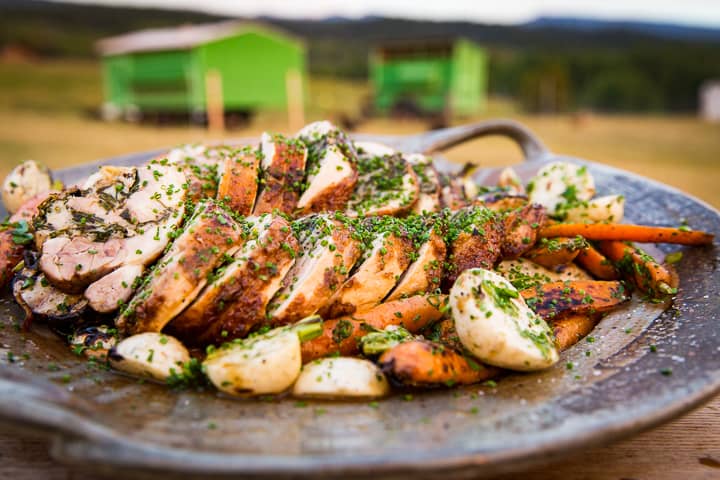There are a handful of basic kitchen skills everyone should know and routinely use. Breaking down a whole chicken is definitely one of them.
Not only does it save you money, it provides more options for healthy meals and it gets easier every time. Besides, butchering a whole chicken just feels amazing, you look cool doing it and it kick-starts your culinary confidence.
Benefits of buying a whole chicken
Cheaper- Why pay more for individual pieces and for someone else to do the easy work? The whole bird is cheaper per pound than most individual pieces and you get the added benefit of the entire carcass and giblets. The leg quarters are usually the cheapest per pound but you’re limited to these cuts.
Homemade Chicken stock- The savings continue when you make your own chicken stock vs store bought. Utilizing the leftover carcass and giblets to create a stock will yield between 1-2 gallons(4-8 quarts) of stock. Now you have an amazing homemade stock for soups, risotto and sauces. Try using your chicken stock instead of water the next time you cook rice, dried beans, or you need to poach something.
Butcher the exact cuts you prefer- Recipes call for their own variety of chicken pieces. Starting with a whole bird gives you every option: whole chicken, half chicken, 4 pieces, 8 pieces, 10 pieces, airline breasts, bone-in, and boneless. You get the point.

Best place to buy a whole chicken
I realize that buying local, organic, biodynamic, pastured, grass-fed, you name it, comes at a premium. But we’ve all heard the saying, “you get what you pay for.” I truly believe this when it comes to buying the food we eat. Simply eating less meat was a way for our family to choose quality over quantity.
While most grocers do carry higher quality options we still prefer to know more about our food, buy directly from the farmer and as local as possible. Not everyone has this option, so I would encourage you to ask around and find the best sources possible.

A few quick ideas:
- Talk with your farmer, local butcher shop, vendors at your local farmers market and fellow CSA members.
- We joined a local chicken CSA. It runs exactly like the more common vegetable share CSA model and allows us to eat local and support local.
- Get on the interwebs and start googling- Farm Match, Local Harvest, Harvie, or check out any of the subscription services.

Alright, you got a whole bird, now what?
1. Let’s start breaking down a whole chicken
Always start with a sharp knife. Your standard chef knife is perfectly fine. A boning knife and kitchen shears are also welcomed options.
2. Rinse and dry the chicken
Start by checking for and removing any giblets from inside the cavity. Then give the chicken a good rinse under running water to remove any leftover blood and loose bits. Pat the bird dry with paper towels, you don’t want to cut a slippery wet chicken.

3. Remove the breasts
With the breast side up find the center breastbone and slice vertically along either side, keeping the knife against the rib cage and wishbone as you peel the breast away. You can then use your hands to remove the tenderloin or cut it out. Repeat with remaining breast.

4. Remove the legs
With the chicken on its side, gently grab the leg and start cutting around the oyster. This is a not-to-be-missed little piece of meat next to the spine and directly in front of the thigh. Next you want to bend the thigh away from you to pop out and reveal the hip socket; cut through the joint to remove leg, cutting as close to the carcass as possible. Repeat the process on the other side.

5. Separate the thigh and drumstick
To locate the joint between the thigh and drumstick you can wiggle the drumstick back and forth or use your fingers to feel the joint indention. Also, if you place the leg quarter skin side down you can see a white ribbon of fat that marks the cut line. However you prefer to find it, simply cut through the joint to separate and repeat with the other side.

6. Remove the wings
Wiggle the wing back and forth to locate the joint. Remove the extra bit of meat along the spine directly in front of the wing then continue to cut through the joint removing the wing from the carcass. You can then separate the wingette from the drumette by slicing through this joint. Once again, repeat with the second wing.

7. Reserve the carcass
Save any remaining chicken parts, giblets and the carcass for making a chicken stock. You can also freeze these parts and stockpile them as you cut up more chickens. Then you can either make the stock at your convenience or a larger amount of stock.

That wasn’t so bad
You’ll have to admit, buying and breaking down a whole chicken is kind of a no-brainer. It may be intimidating at first but like anything in life, practice makes perfect.
If you really want to challenge yourself and set a personal speed record in the process, check out Chef Martin Yan break down a chicken in 18 seconds. He also offers some cool tips and makes the wingette into a drumstick.

Some ideas for your next whole chicken
- Deboned Whole Chicken Stuffed with Braised Kale and Collards
- Cast Iron Spatchcocked Chicken with Crispy Grilled Kale
- Ticket Spike, Al pastor style, Chicken tacos
- Grilled Shiitake Mushroom & Thai Chicken Lettuce Wraps with Spicy Finger Lime Peanut Vinaigrette
Happy butchering and let us know your thoughts on buying and breaking down a whole chicken.
8
Leave a Reply